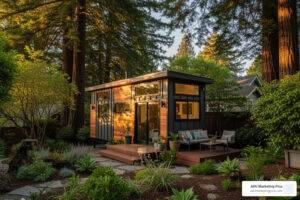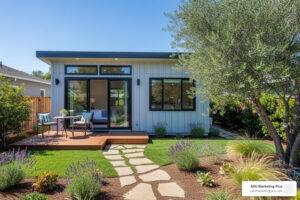Why ADU Customer Acquisition Is Critical for Construction Success
ADU customer acquisition has become essential for builders and architects as California led the nation with nearly 23,000 ADUs built in 2023—more than double the 10,000 built in 2021. Yet with 69,000 permits pulled but only 44,000 ADUs actually constructed between 2019-2023, there’s a massive gap between homeowner interest and completed projects.
Quick Answer: Top ADU Customer Acquisition Strategies
- Digital Marketing Channels: Google Ads, Facebook/Instagram visuals, local SEO
- Lead Capture: Short forms with value offers (guides, cost calculators)
- Financing Solutions: In-house POS financing to reduce buyer friction
- Local Expertise: Position regulatory knowledge as competitive advantage
- Target Metrics: $50-$150 Cost Per Lead, 3:1 Lifetime Value to CAC ratio
The ADU boom creates both opportunity and intense competition. Homeowners face construction costs of $150,000-$300,000 for sub-1,000 square foot units, making the decision process complex and lengthy. Meanwhile, builders struggle with lead quality, long sales cycles, and differentiating themselves in crowded markets.
This guide breaks down proven strategies to attract, nurture, and convert high-value ADU prospects into profitable projects.

Quick ADU customer acquisition definitions:
Rising Demand & Target Customer Profiles
The ADU customer acquisition landscape is red-hot right now. California pulled 69,000 ADU permits between 2019-2023, but only managed to build 44,000 actual units. That’s a 40% gap between homeowner interest and completed projects—thousands of motivated homeowners with permits in hand, looking for the right builder.
This gap represents real families facing real challenges: aging parents who want independence, young adults priced out of the rental market, and homeowners struggling with mortgage payments who see rental income as their lifeline.

The biggest barriers stopping these homeowners? Financing confusion, regulatory overwhelm, and finding qualified builders who understand ADU construction. Smart builders who solve these pain points capture significant market share.
What Is an ADU & Why Demand Is Surging
An ADU—or Accessory Dwelling Unit—is a self-contained mini-home on the same property as a main house. A complete living space with kitchen, bathroom, bedroom, and living area, typically under 1,000 square feet.
The demand surge stems from California’s game-changing legislation between 2016-2023. Streamlined approvals, reduced fees, eliminated parking requirements—suddenly, building an ADU went from bureaucratic nightmare to manageable project.
Other states are following. Hawaii passed SB 3202, Oregon is loosening restrictions, and cities nationwide recognize ADUs as politically smart solutions to housing shortages. Scientific research on accessory dwelling trends shows these aren’t temporary fixes—they’re permanent parts of America’s housing landscape.
The economics make sense. With construction costs running $300-$600 per square foot in markets like San Diego, a well-positioned ADU can generate $1,500-$3,500 monthly rental income. For homeowners sitting on equity but struggling with cash flow, that’s life-changing money.
Primary Customer Segments & Their Pain Points
Equity-rich homeowners (45% of market) have substantial home equity and see ADUs as rental income tickets. They’re motivated by offsetting mortgage costs or creating retirement income. Their biggest fears? Unclear ROI calculations and construction cost overruns. They budget $200,000-$400,000 and prefer 6-12 months to plan.
Multigenerational families (25% of demand) often have emotional urgency. Maybe mom needs care but wants her own space, or adult kids are moving back home. They’re dealing with privacy concerns and complex family dynamics. Budget ranges $150,000-$300,000, but timelines are compressed due to family circumstances.
Real estate investors (20% of projects) want maximum property yields but are frustrated by permit complexity and construction management. They budget $180,000-$350,000 and want aggressive timelines to generate cash flow quickly.
Downsizing seniors (10%) are often most committed once they decide. They plan to move into the ADU while renting their main house. Accessibility requirements and fixed income constraints are major concerns, with budgets $120,000-$250,000.
Each group needs different messaging. More info about ADU SEO California shows how search behavior varies dramatically across demographics.
Designing the ADU Customer Acquisition Funnel
Building a successful ADU customer acquisition system isn’t like selling kitchen renovations. We’re talking about projects costing $150,000 to $300,000 that take homeowners months to decide on. You need a funnel built for the long haul.
Think about your customer’s perspective. They’re not just buying construction—they’re making a major financial decision that could change their living situation, generate rental income, or house aging parents.
The most successful ADU builders understand this complexity. They’ve built acquisition funnels that nurture prospects through multiple touchpoints, provide genuine value at each stage, and build trust over time.

Mapping the Journey From Click to Contract
Your prospects go through four distinct stages before signing contracts.
Problem-aware homeowners know they need more space or income but haven’t zeroed in on ADUs. They’re searching “backyard rental ideas” or “housing options for elderly parents.” Your job is educating them about possibilities with blog posts about ADU basics and regulatory overviews. Goal: get them on your email list.
Solution-aware prospects have finded ADUs but need to determine if it makes sense. Now they’re googling “ADU cost calculator” and “ADU builders near me.” Shine with detailed cost guides, design galleries, and permit explanations. Move them toward scheduling consultations.
During evaluation, they’re comparing builders, getting quotes, making final decisions. They’re researching reviews, timelines, financing options. Your case studies, testimonials, and payment plan information become crucial.
After project completion, happy customers become your best marketing asset through referrals, reviews, and project showcases.
Lead Capture & Nurturing Best Practices
Keep initial forms short. Ask for name, email, phone, project timeline—that’s it. The moment you ask about budget or property details, conversion rates drop by half.
Use progressive profiling to gather more information through email sequences and follow-up conversations.
Your value offers need to solve real problems. ADU cost calculators giving realistic location-based estimates work incredibly well. So do local permit guides and design galleries with cost breakdowns.
Combine email with SMS reminders—this increases conversion rates by 35%. People are busy, and gentle text reminders about requested consultations make all the difference.
Your automated sequence should feel helpful, not pushy. Start with welcome email including cost calculator. Send permit guide after few days. Share design inspiration and customer stories. Around day 14, introduce financing options. Day 21, offer limited-time consultation.
Winning ADU Customer Acquisition Channels
Google Ads consistently deliver highest-quality leads because people actively search for ADU solutions. Focus on location-specific keywords like “ADU builder San Jose” and problem-focused terms like “backyard rental construction.”
Local SEO provides most cost-effective leads long-term. Create content around city-specific searches like “ADU permits in Mountain View.” Keep Google My Business updated and gather local citations.
Facebook and Instagram excel at visual storytelling. Before-and-after photo carousels perform incredibly well, especially with cost information. Target homeowners aged 35-65 in high-value zip codes interested in home improvement.
YouTube builds authority through educational content about permit processes, design consultations, customer interviews. Retarget website visitors with project showcases.
Geo-fencing targets specific neighborhoods where ADUs are popular. Set up digital fences around home improvement stores and real estate offices.
More info about ADU Lead Generation covers additional tactics for maximizing each channel’s potential.
Financing, Local Expertise & Regional Strategy
Here’s the truth about ADU customer acquisition: most homeowners want to build, but they’re stuck on payment. A 2023 Freddie Mac survey revealed only 22% would finance ADU builds with personal savings. That means 78% need financing help—your golden opportunity.
When you integrate financing solutions, you’re not just offering construction services. You’re solving the biggest problem between homeowners and their dream ADU. This transforms you from “another contractor” into “the builder who makes ADUs possible.”

Financing Options That Shorten the Sales Cycle
Point-of-Sale financing is a game-changer. When you can approve financing during initial consultations, you eliminate the biggest objection before it derails sales. Builders increase close rates by 40-60% simply by offering flexible payment options on the spot.
Modern POS financing platforms offer impressive features. Multi-lender waterfall systems automatically try multiple lenders to maximize approvals. Stage funding aligns payments with construction milestones. Change order financing handles project modifications without killing deals.
Home Equity Lines of Credit remain most popular for ADU financing, but many homeowners don’t realize they can access equity for construction. When you educate prospects about HELOC options and partner with local credit unions, you provide valuable guidance that builds trust.
Stage funding solutions address homeowners’ biggest fear: paying large sums upfront. Breaking payments into construction milestones like foundation, framing, electrical, and completion reduces their risk while improving your cash flow.
Local Regulations as a Competitive Advantage
Nothing overwhelms potential ADU customers like zoning codes and permit processes. While competitors treat regulatory knowledge as necessary evil, smart builders use it as their secret weapon.
When you simplify regulatory complexity, you become the trusted expert who makes the impossible seem possible. Homeowners choose you over lower-priced competitors because you eliminate their biggest headache.
Your regulatory expertise should cover: setback requirements and lot coverage limits, parking waiver eligibility, fast-track permit programs, utility connection requirements, and design review processes.
Create jurisdiction-specific permit guides homeowners can’t find elsewhere. Offer free regulatory consultations demonstrating expertise before prospects request quotes. Some builders guarantee permit approval or refund fees, virtually eliminating regulatory risk.
Regional Playbook: California & Beyond
California created the nation’s largest ADU market, but success requires understanding regional variations.
In the San Francisco Bay Area, construction costs run $400-$600 per square foot, but rental demand hits $2,500-$4,000 monthly. Focus heavily on ROI calculations and financing solutions.
Los Angeles presents different challenges with diverse neighborhoods and varying regulations. Success comes from emphasizing design flexibility and demonstrating local permit expertise.
San Diego offers the sweet spot of reasonable construction costs with strong rental demand at $1,500-$3,500 monthly. Highlight both investment potential and cash flow projections.
Beyond California, emerging markets offer first-mover advantages. Hawaii’s SB 3202 allows up to two ADUs per lot—perfect for emphasizing sustainability benefits.
Oregon shows growing ADU acceptance in Portland and Eugene. Focus messaging on affordable housing benefits and environmental impact.
Denver presents massive opportunity despite 35% zoning allowance—only 278 ADUs built since 2018. Early movers can establish themselves as go-to ADU experts.
Latest research on HI SB3202 shows how state legislation continues expanding ADU opportunities beyond California.
Metrics & Optimization for ADU Customer Acquisition
The numbers tell the story. When investing in ADU customer acquisition, you need to know what’s working. With ADU projects averaging $150,000 and generating referrals 20% of the time, you can afford higher customer acquisition costs than typical construction companies—but only if you’re tracking the right metrics.

One customer can be worth $180,000 to $220,000 over their lifetime when you factor in the original project plus referrals and additional services.
Calculating CPL & CAC in ADU Customer Acquisition
Cost Per Lead (CPL) is how much you spend to get someone interested. For ADU builders, this runs higher than general construction because you’re targeting homeowners with significant equity and specific property requirements.
Here’s what we’re seeing: Google Ads cost $75-$200 per lead, Facebook and Instagram run $45-$120. SEO and organic traffic delivers best value at $25-$75 per lead but takes time to build. Direct mail works in affluent neighborhoods at $100-$300 per lead.
Customer Acquisition Cost (CAC) is the bigger picture—everything you spend to turn a lead into a paying customer. Calculate by adding marketing spend plus sales costs, then dividing by new customers signed.
Organic channels like SEO and referrals provide lower CAC but require patience. Paid channels like Google Ads deliver faster results but cost more upfront. Most successful ADU builders use hybrid approaches balancing both.
Customer Lifetime Value & Referral Uplift
Your average customer isn’t just worth their $150,000 project. Start with base project revenue of $150,000. Add the referral multiplier—20% of satisfied customers refer friends or family. Factor in additional services since 15% build second ADUs or hire you for other renovations. Suddenly, customer lifetime value jumps to $180,000-$220,000.
This means you can afford much higher CAC than other construction companies. Aim for 3:1 LTV to CAC ratio minimum, with 5:1 being healthier. Based on conservative lifetime value calculations, you could spend $36,000-$44,000 to acquire a customer and remain profitable.
Formal referral programs boost referral rates from 20% to 35%. Consider cash incentives of $1,000-$2,500 for qualified referrals, service credits for maintenance, or recognition programs showcasing customer projects.
Measuring ROI & Continuous Improvement
Sustainable ADU customer acquisition requires continuous optimization based on real data. Track lead volume and quality scores to understand which channels bring serious buyers versus tire-kickers. Monitor conversion rates by channel to see where your message resonates.
Pay attention to sales cycle length—ADU purchases typically take 6-18 months. Track where prospects get stuck and address bottlenecks with better content or sales processes.
Customer satisfaction scores and Net Promoter Scores predict future referrals better than any other metric. Happy customers become your best marketing channel.
A/B testing should focus on biggest impact opportunities: landing page headlines, lead capture forms, email subject lines, ad creative and targeting, and follow-up sequences.
Set up optimization cycles: review campaign performance weekly, test landing pages monthly, adjust channel mix quarterly, and conduct comprehensive customer research annually.

ADU customer acquisition rewards builders who think beyond immediate project revenue. When you factor in lifetime value and referral potential, you can invest more aggressively in marketing while maintaining healthy profit margins.
Frequently Asked Questions about ADU Customer Acquisition
How much should I budget per lead for ADUs?
ADU customer acquisition costs more than typical construction leads, but the payoff makes it worthwhile. You’re looking at $75-$200 per lead depending on your approach and local competition.
Google Ads hit $100-$200 per lead, but these prospects are actively hunting for ADU solutions. Facebook and SEO can get you down to $50-$120 per lead with smart optimization.
Here’s what changes everything: your average ADU project is worth $150,000. Add that 20% referral rate, and suddenly paying $150 for a quality lead looks reasonable. Start with $5,000-$10,000 monthly to generate 25-50 solid leads.
If you close just one project per month from marketing efforts, you’ve likely covered your entire annual advertising budget.
Which digital channel converts best for ADU builders?
Google Ads take the crown for conversion rates, typically hitting 8-15%. Someone searching “ADU builder near me” is pretty serious about moving forward.
But the magic happens when you combine channels. Google Ads grab immediate attention, SEO builds long-term foundation, and Facebook shows off gorgeous before-and-after photos that get homeowners dreaming.
Email nurturing is your secret weapon for those 6-18 month decision cycles. Most homeowners need time to wrap their heads around $200,000 backyard projects.
Local SEO gives you the best bang for your buck over time. Paid ads deliver immediate results, but you pay every time.
How long before I see ROI on my campaigns?
Patience is your friend in ADU marketing. Plan for 3-6 months before seeing real traction, and 6-12 months for full ROI. You’re asking families to make one of their biggest financial decisions.
The first couple months feel like shouting into the void while setting up campaigns. Months 3-4 are when leads start flowing and real conversations begin. By months 4-6, you should see first contracts getting signed.
The beautiful part happens in months 6-12 when projects wrap up and happy customers start referring neighbors. That’s when your marketing investment really pays dividends.
SEO takes longest—sometimes 6-12 months for serious results. But once you rank well for “ADU builder [your city],” you’ve got a lead machine that works while you sleep.
Conclusion
The ADU customer acquisition landscape is shifting rapidly, and builders who master these strategies now will own the market for years to come. California alone has a 40% gap between ADU permits pulled and actual completions—homeowners want ADUs, but they’re getting lost between initial interest and breaking ground.
The solution requires a complete mindset shift. Successful ADU customer acquisition means thinking like a trusted advisor, not a typical contractor. Your prospects are making $150,000+ decisions while navigating complex regulations, financing options, and family dynamics.
Start with your customers, not your services. The equity-rich homeowner researching rental income has completely different concerns than the multigenerational family needing privacy for aging parents.
Build systems that nurture relationships over time. Most ADU decisions take 6-18 months. Your competition sends one follow-up email then gives up. You’ll win by staying helpful and visible throughout their entire journey.
Make financing simple and accessible. When you remove the biggest barrier to ADU construction, you don’t just get more customers—you get better customers who can actually afford to move forward.
Position your regulatory expertise front and center. Every homeowner feels overwhelmed by permits, setbacks, and zoning requirements. The builder who makes this simple wins the project.
Track your cost per lead, customer acquisition cost, and lifetime value religiously. With proper measurement, you can justify spending $200+ per lead because each customer is worth $150,000+ in revenue plus referrals.
Most importantly, ADU customer acquisition is a long-term game. SEO takes months to build momentum. Nurturing sequences convert prospects slowly. But once you establish these systems, they create sustainable competitive advantages that can’t be easily copied.
The ADU boom is just getting started. Hawaii’s new legislation, Oregon’s expanding programs, and other states following California’s lead mean this opportunity will only grow. The builders who invest in proper customer acquisition now will dominate these emerging markets.
Ready to stop competing on price and start attracting customers who value your expertise? More info about ADU Marketing Solutions to find how we can help you stand out by focusing on expertise over price.




